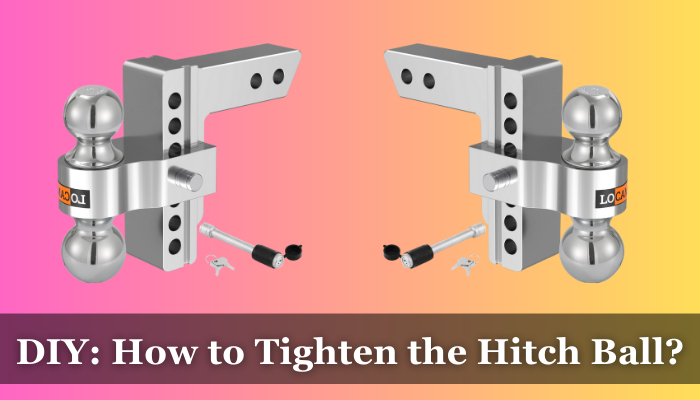This post may contain affiliate links which means I may receive a small commission for purchases made through the links. Learn More
When it comes to towing, one of the most important things to consider is the tightness of the hitch ball. If you don’t tighten the hitch ball properly, the chances of the hitch getting detached increase which can cause safety problems.
But, this guide is going to give you a complete step-by-step process of tightening the hitch ball. Here is the summary of the steps that you will have to follow:
- Position the hitch ball under the trailer’s coupler
- Use the wrench or socket set to tighten the nut
- Use the torque wrench for further tightening and maintain tension
- Inspect the Ball and Coupler to see if the hitch ball is tight or loose
- Test the Tightness of the Ball by driving the vehicle slowly
Excited to learn the complete process? Let’s dive into the details, and discuss the tightening of the hitch ball.
Related Article: How to Lift a 5th Wheel Hitch Out of a Truck?
What is Hitch Ball?
Before I talk you to the more advanced part of this guide, you need to understand what a hitch ball is and why it is important.
It is a ball-shaped component that connects the vehicle and trailer. In simple words, it is the connection point and if it is not tightened properly, then the trailer can get too loose or even detached from the vehicle.
There are different types of hitch balls present in the market. All of those have different sizes and specifications and they also vary in price as well. In the below section, I will give you some type of hitchball that will further give you an insight into things.
- Chrome Hitch Balls
- Aluminum Hitch Balls
- Forged Steel Hitch Balls
- Stainless Steel Hitch Balls
I hope that now you have some basic information and are ready to go into the steps that will help you tighten the hitch ball if you already have them.
Step-by-Step Guide: How to Tighten the Hitch Ball?
The first, and most important thing is to make sure that you have the correct size hitch ball for your towing needs. Look, the specification of every hitch ball varies and you will have to choose the right size that your trailer needs.
It would be ideal if you read the owner’s manual for your vehicle for once as it will give you information about the correct size of the hitch ball that your trailer needs.
Now, let’s talk about tightening a hitch ball. It is a relatively simple process, you will have to follow the steps carefully to ensure that the ball is tightened to the proper tension. Here is a step-by-step guide to tightening a hitch ball:
Step 1 – Position the hitch ball under the trailer’s coupler
First of all, you will have to position the hitch ball under the trailer’s coupler. Make sure that the ball is centered and that the coupler is securely attached to the ball. If you feel that you’ve placed or positioned the hitch ball wrongly, then adjust it accordingly and ensure that the hitch ball correctly goes to its place.
Step 2 – Use the wrench or socket set to tighten the nut
Once the hitch ball is present at the center of the coupler then you will need to use the wrench and tighten the nuts that hold the hitch ball in place. Make sure that the nut is tightened as much as possible by hand before using the torque wrench.
Note: Always make sure that the hitch ball is the correct size for the weight of the trailer. A ball that is too small for the trailer can cause the coupler to come loose or even break
Step 3 – Use the torque wrench to maintain tension
Once you have tightened the nuts with a wrench, now you will need to tighten the nut again to the proper tension with the help of a torque wrench. The exact tension will depend on the size of the hitch ball and the weight of the trailer. Most of the time, the user manual has all the information about the tension specification. If you don’t find it in the user manual, then you can call the manufacturers.
Note: A torque wrench ensures that the ball is tightened to the correct tension and prevents over-tightening, which can cause damage to the hitch ball or the vehicle.
Step 4 – Inspect the Ball and Coupler
I’m sure that you have now tightened the nuts and kept a specific tension with the help of wrench torque. Now Inspect the ball and coupler to make sure everything is properly aligned and securely attached.
Step 5 – Test the Tightness of the Ball
Never make the mistake of towing the trailer immediately once you have completed the process of tightening the hitch ball. Instead, you should double-check the tightness of the hitch ball. You can drive the wheel with a towed trailer slowly and see the result. If you don’t feel any issues then you’re good to go.
Things to Consider While Tightening the Hitch Ball
Properly maintaining your hitch ball is important to ensure that it stays in good working condition. Ignoring this aspect can lead you towards compromising your safety. Below are some important points that you must consider when tightening the hitch ball.
- Regularly inspect the hitch ball for wear or damage
- If you see any rust, remove it immediately as it can weaken your hitch ball.
- I recommend you lubricate the hitch ball and coupler with high-quality grease to make them safe from rust.
Should the Hitch Ball be Greased?
Yes, the hitch ball should be greased as it eases the process of tightening the hitch ball. It also becomes easier to connect the trailer with the tow vehicle. The greased hitch ball won’t get rust as well which is a big plus if you are from an area where moisture is common.
There are different opinions: some people believe that greasing or lubricating the hitch ball is a good idea, whereas some people believe that lubricating the hitch ball makes it messy. But, I am a big believer that the greased hitch ball does more good than bad.
Although, during the tightening of the hitch ball, your hands will get messy, in the long run, the greased hitch ball won’t rust. You will be able to remove, tight, and adjust the hitch ball quite easily due to its better grip that it keeps due to proper lubrication. So, big YES for greasing or applying any other lubricant.
Frequently Asked Questions
The hitch ball should be tightened until there is no play or movement between the ball and the ball mount. Stop tightening the hitch ball when you feel there is no movement or looseness.
Most hitch balls will require a tool, such as a wrench or a socket, to tighten them properly. You won’t be able to tighten the hitch ball with your hands.
Yes, over-tightening the hitch ball can cause damage to the hitch ball or the ball mount.
Conclusion
Properly tightening a hitch ball is crucial for towing safety and peace of mind. If you don’t pay heed to it, then chances are high that you’ll face some consequences. In this guide, I’ve given you step by steps processing for tightening the hitch ball. I hope that this guide will add value and excel you one step forward towards safe toying.

I’m Ahmad – the owner of this website and the writer of this post. I’ve spent 15 years in the automotive industry, especially among the hitches. What you’re reading is the experience of my 15 years.

